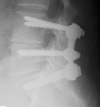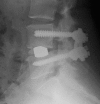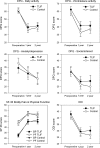Transforaminal lumbar interbody fusion (TLIF) versus posterolateral instrumented fusion (PLF) in degenerative lumbar disorders: a randomized clinical trial with 2-year follow-up
- PMID: 23584162
- PMCID: PMC3777065
- DOI: 10.1007/s00586-013-2760-2
Transforaminal lumbar interbody fusion (TLIF) versus posterolateral instrumented fusion (PLF) in degenerative lumbar disorders: a randomized clinical trial with 2-year follow-up
Abstract
Purpose: The aim of the present study was to analyze outcome, with respect to functional disability, pain, fusion rate, and complications of patients treated with transforaminal lumbar interbody fusion (TLIF) in compared to instrumented poserolateral fusion (PLF) alone, in low back pain. Spinal fusion has become a major procedure worldwide. However, conflicting results exist. Theoretical circumferential fusion could improve functional outcome. However, the theoretical advantages lack scientific documentation.
Methods: Prospective randomized clinical study with a 2-year follow-up period. From November 2003 to November 2008 100 patients with severe low back pain and radicular pain were randomly selected for either posterolateral lumbar fusion [titanium TSRH (Medtronic)] or transforaminal lumbar interbody fusion [titanium TSRH (Medtronic)] with anterior intervertebral support by tantalum cage (Implex/Zimmer). The primary outcome scores were obtained using Dallas Pain Questionnaire (DPQ), Oswestry disability Index, SF-36, and low back pain Rating Scale. All measures assessed the endpoints at 2-year follow-up after surgery.
Results: The overall follow-up rate was 94 %. Sex ratio was 40/58. 51 patients had TLIF, 47 PLF. Mean age 49(TLIF)/45(PLF). No statistic difference in outcome between groups could be detected concerning daily activity, work leisure, anxiety/depression or social interest. We found no statistic difference concerning back pain or leg pain. In both the TLIF and the PLF groups the patients had significant improvement in functional outcome, back pain, and leg pain compared to preoperatively. Operation time and blood loss in the TLIF group were significantly higher than in the PLF group (p < 0.001). No statistic difference in fusion rates was detected.
Conclusions: Transforaminal interbody fusion did not improve functional outcome in patients compared to posterolateral fusion. Both groups improved significantly in all categories compared to preoperatively. Operation time and blood loss were significantly higher in the TLIF group.
Figures




References
-
- Christensen FB, Hansen ES, Eiskjaer SP, et al. Circumferential lumbar spinal fusion with Brantigan cage versus posterolateral fusion With Titanium Cotrel-Dubousset instrumentation: a prospective, randomized Clinical study of 146 patients. Spine. 2002;27(23):2674–2683. doi: 10.1097/00007632-200212010-00006. - DOI - PubMed
Publication types
MeSH terms
LinkOut - more resources
Full Text Sources
Other Literature Sources

